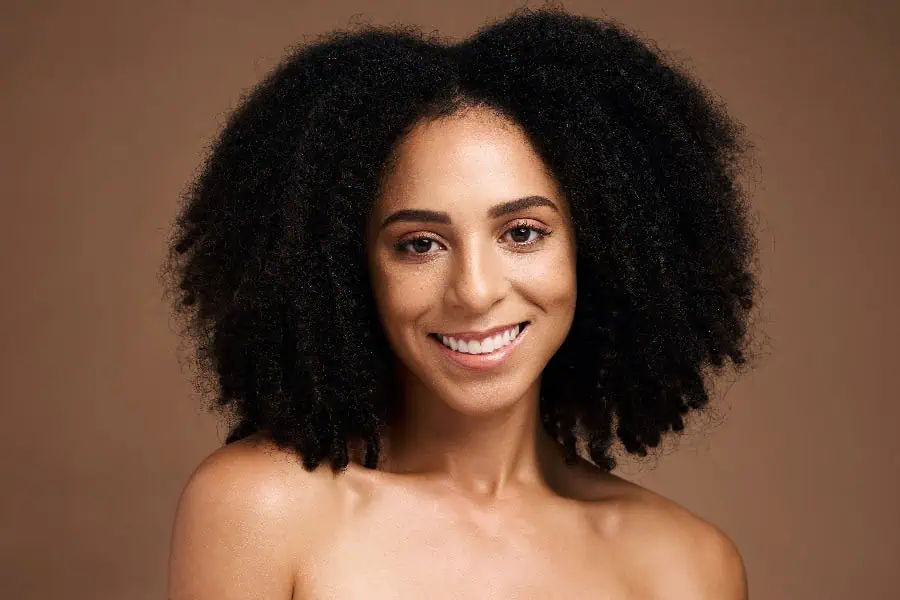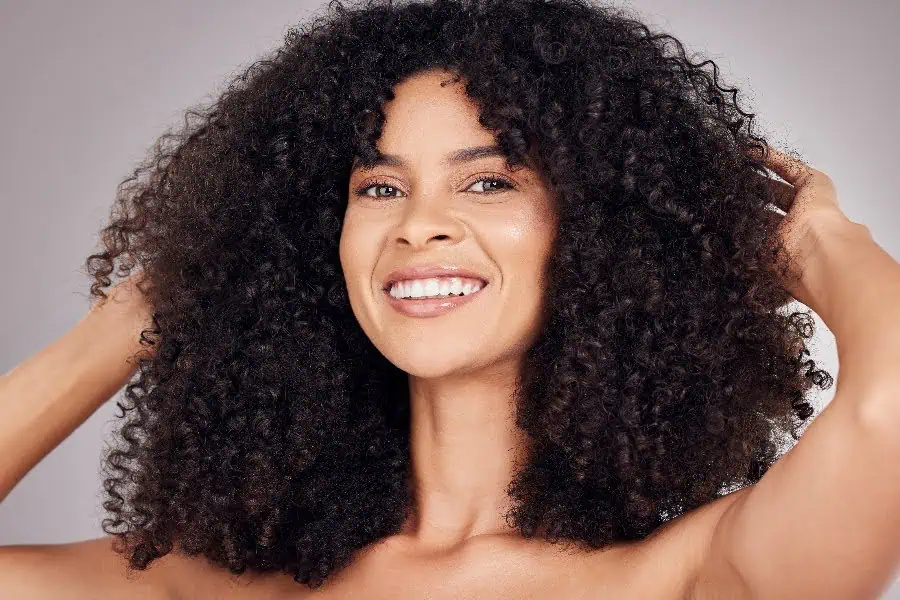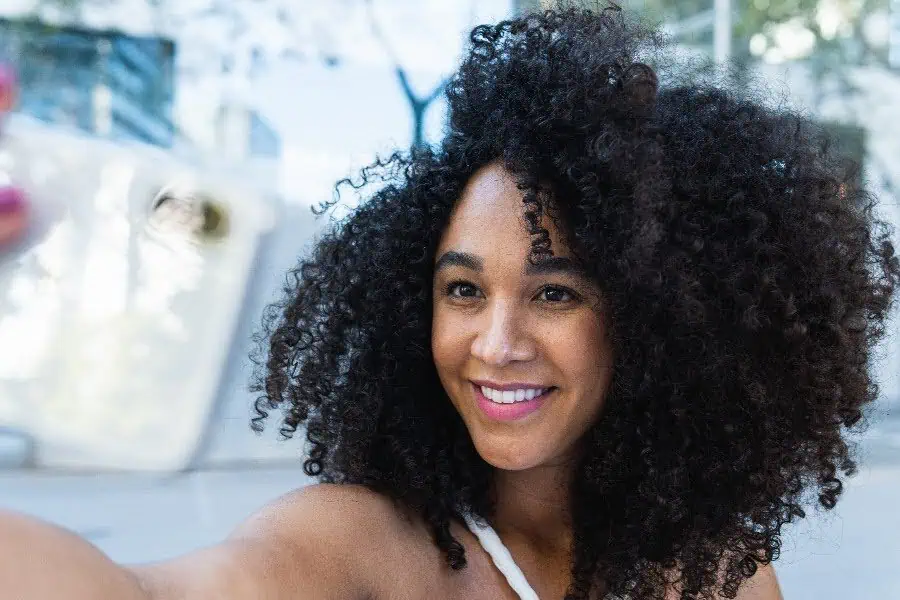
- Free Standard Shipping To Au On Orders $150+

3C hair is characterised by tight, corkscrew-shaped curls that are dense and full of volume. This hair type tends to have a high level of texture and can vary significantly in thickness.
Understanding one’s curl type is essential for effective hair care. Each curl type has different moisture and styling requirements. For 3C curls, incorporating moisture-rich products is vital to maintaining curl definition and managing frizz.
Curl Shape: Tight corkscrew curls.
Texture: Thick and dense.
Moisture Needs: High; prone to dryness.
1. Moisturise: Regular deep conditioning is crucial. Products like Waves & Curls Moisturising Conditioner can help retain moisture.
2. Avoid Heat: Minimise the use of heat styling tools to prevent damage.
3. Use Curl Creams: Curl-enhancing creams can define curls without weighing them down.
4. Gentle Detangling: Use a wide-tooth comb or fingers while the hair is wet to prevent breakage.
Understanding hair porosity is also important in creating an effective care routine. Those with low porosity hair may notice products tend to sit on the surface rather than absorb, requiring lighter, water-based products and gentle heat to open the cuticle. High porosity hair absorbs moisture quickly but loses it just as fast, often benefiting from richer, sealing products like butter and oils.
By recognising the specific needs of 3C curls, individuals can ensure their curls remain healthy, defined, and vibrant.

3C hair is characterised by tight, densely packed, curly hair, approximately the diameter of a pencil. These curls form a corkscrew pattern, which is distinct from other curly hair types.
For comparison:
3A: Loose, shiny curls that are more elongated.
3B: Medium-sized curls that are springy and voluminous.
4A: Tighter, more defined curls that often have a zigzag pattern.
Individuals with 3C curls often face specific challenges. Shrinkage is common, meaning the hair may appear shorter than its actual length when dry due to the curl’s tightness.
Frizz can also be a concern, as the hair tends to be drier. This is due to oils having difficulty travelling down the spiral and tight curl pattern, leading to a need for regular moisturisation.
When identifying 3C, individuals should observe the curl formation. If the curls are small and tightly coiled, it is likely 3C. Recognising these characteristics is essential for effective hair care.
Some individuals with 3C hair may also notice a combination of curl patterns, including loose curls mixed with tight coils, especially around the nape or edges. An S-shaped pattern in some strands can further differentiate the curl texture and influence product choices and styling techniques.
Unlike straight hair, managing 3C curly hair can take more effort. Caring for 3C hair requires a structured approach, focusing on cleansing, conditioning, moisturising, and detangling hair regularly. Each step plays a vital role in maintaining the health and beauty of these unique curls.
Cleansing 3C curls is essential for removing product buildup and excess oils. It is recommended to choose a sulphate-free shampoo. Sulphates can strip natural oils, leaving hair dry. A gentle cleanser maintains moisture levels while ensuring cleanliness.
To avoid stripping moisture, use warm water to wet hair. Focus on the scalp, massaging gently to stimulate circulation. Rinse thoroughly to ensure no product residue remains. Aim to cleanse the hair once a week or bi-weekly, depending on lifestyle and hair needs. This schedule helps prevent dryness and keeps curls healthy.
Conditioning is crucial for 3C curly hair, which tends to be drier due to its curl pattern. A rich, hydrating conditioner will help replenish moisture. Look for products containing ingredients like shea butter or coconut oil.
Apply conditioner generously, focusing on the mid-lengths to the ends of the hair. Allow it to sit for a few minutes to absorb fully. For added benefits, consider a deep conditioning treatment once a month. These treatments penetrate deeper into the hair shaft, providing extra nourishment and enhancing curl definition.
Moisturising 3C curly hair is vital for preventing dryness and ensuring curls remain defined. The LOC method (Liquid, Oil, Cream) is an effective approach. Begin with a hair moisturiser or leave-in conditioner to hydrate the hair.
Follow with an oil, such as argan or jojoba, to seal in moisture. Finish with a curl cream to define the curls and provide hold. This combination infuses moisture and keeps the hair soft and elastic. Frequent moisturising, especially in dry climates, maintains curl integrity and bounce.
For those practising co-washing, using a cleansing conditioner can help retain natural oils while still refreshing the scalp. This method is particularly beneficial for people with dry or highly porous hair, as it helps avoid the stripping effects of traditional shampoos.
Detangling can be challenging for 3C hair due to its texture. It is advisable to detangle when the hair is damp and conditioned. Use a wide-tooth comb or fingers to gently work through knots.
Divide the hair into sections for easier management. Start detangling from the tips and gradually move up towards the roots. This method reduces breakage and damage. It is also beneficial to use a detangling spray to aid the process and enhance slip.
To distribute evenly and avoid clumping or tangles, always work your moisturisers or styling products through small sections of hair. Finger detangling can be especially effective for ensuring even product distribution without causing unnecessary stress to delicate curls.
Regular detangling curl clumps, ideally once a week, keeps curls defined and reduces the risk of knots.

Achieving beautiful 3C curls requires specific styling techniques. Key aspects such as defining the curls, reducing frizz, protective styling, and employing heat styling can greatly enhance the appearance and health of the hair.
To define 3C curls effectively, it’s crucial to start with clean, damp hair. Applying a moisturising curl cream helps to enhance curl pattern and texture. Using the LOC method (Liquid, Oil, Cream) promotes moisture retention.
Section the hair into manageable parts, making it easier to work the product in. Use the “praying hands” method to smooth the product over curls or scrunch the hair to encourage formation. Another technique involves using a Denman brush to define curls while distributing the product evenly.
Regularly trimming the hair also encourages better curl formation, removing split ends that can disrupt curl patterns.
Frizz control is essential for maintaining sleek 3C curls. Start with a sulphate-free shampoo to cleanse without stripping moisture. Incorporating a deep conditioning treatment into the weekly routine enhances hydration.
To minimise frizz post-styling, avoid touching the hair once styled. Let curls air dry whenever possible, as diffuser drying can increase frizz. Applying a light hair oil can help seal moisture while smoothing down any flyaways.
Choosing the right microfibre towel over a regular towel reduces friction, which can contribute to frizz. Additionally, using a silk or satin pillowcase will further prevent friction during sleep, preserving curl definition.
Protective styles are ideal for maintaining 3C curly hair health. Options such as braids, twists, and buns protect the hair from environmental damage and reduce manipulation. Before styling, ensure the hair is well-moisturised to prevent breakage. Using hair accessories that won’t snag the hair is essential. Avoid tight styles that can lead to tension-related hair loss.
Popular protective styles such as twist-outs and braid-outs not only reduce manipulation but also help define curl patterns without heat. These styles stretch the hair while maintaining curl integrity, making them excellent options for both length retention and style versatility.
Additionally, wearing a scarf or bonnet when sleeping can safeguard curls from friction. This not only helps maintain the style but also retains moisture, ensuring the hair remains healthy over time.
When heat styling is necessary, precautions are vital for protecting delicate 3C hair. Using a heat protectant spray is non-negotiable. It creates a barrier that helps shield hair from thermal damage.
If you can’t avoid heat styling, opt for low-heat settings on styling tools. A diffuser attachment on blow dryers can help distribute heat evenly when drying. Limit the frequency of heat styling to prevent long-term damage.
Lastly, follow up with hydrating treatments post-heat styling to replenish moisture. Deep conditioning aids in restoring the hair’s natural curl pattern, keeping it healthy and vibrant after any heat exposure.
Protecting 3C hair during sleep is essential for maintaining moisture and preventing breakage. Proper care at night can significantly improve its texture and appearance.
Using satin or silk materials for hair accessories and pillowcases is highly recommended. These fabrics reduce friction compared to cotton, helping to minimise frizz and maintain curl definition.
She can choose a silk or satin scarf or a bonnet to wrap her hair securely. This method keeps moisture locked in and protects the curls throughout the night.
Another effective technique is the “pineapple” method. This involves loosely gathering the hair at the top of the head like a pineapple. This position helps preserve the curl pattern and prevents flattening while she sleeps.
It’s also helpful to apply a light leave-in conditioner or oil before bed. This extra layer hydrates the hair and allows for a smoother appearance in the morning.
Incorporating these practices into her nighttime routine can lead to healthier, more manageable 3C hair, ready for styling the next day.

3C curly hair presents unique challenges that can affect its health and appearance. This curly hair type often deals with issues such as dryness, shrinkage, breakage, and scalp health. Addressing these concerns with targeted solutions in your hair care routine is essential for maintaining vibrant and manageable curls.
Dryness is a common issue faced by those with 3C hair. This hair type tends to lose moisture quickly due to its tight curls, which make it harder for natural oils from the scalp to travel down the hair shaft.
To combat this, regular deep conditioning treatments are crucial. Look for products rich in ingredients like shea butter, coconut oil, and argan oil. These help retain moisture and provide nourishment.
Incorporating a leave-in conditioner after washing can also aid in keeping hair hydrated throughout the day. Additionally, using a microfibre towel to dry hair helps reduce moisture loss, as it is less absorbent than cotton.
Shrinkage is another prominent characteristic of 3C hair, often leading to frustration regarding hair length. This phenomenon occurs because the tight curls naturally contract due to humidity or lack of moisture.
To manage shrinkage, using a stretch method, like braiding or twisting hair while damp, can help elongate curls. Another effective technique is the ‘banding’ method, which involves securing sections of hair with hair ties to stretch them out.
In addition, applying styling products that provide hold without weighing hair down can prevent excessive shrinking while enhancing curl definition.
Breakage can severely affect the health of 3C hair, leading to split ends and uneven length. Factors contributing to breakage include dryness, improper detangling, and heat damage from styling tools.
To minimise breakage, it is essential to use a wide-tooth comb or fingers while detangling, particularly when hair is wet and conditioned. Avoiding tight hairstyles also helps reduce stress on hair strands.
Utilising protective styles, such as twists or braids, can shield ends from environmental damage. Regular trims every 6 to 8 weeks can also help remove damaged ends, promoting healthier growth.
Maintaining a healthy scalp is vital for 3C curly hair growth and overall hair health. Issues like dryness, flakiness, or irritation can affect hair vitality.
To promote scalp health, regular cleansing with a gentle, sulphate-free shampoo is recommended. This helps remove product buildup without stripping natural oils.
Incorporating scalp massages with nourishing oils, such as tea tree or jojoba, can stimulate blood circulation and alleviate dryness. It’s also beneficial to ensure that products used on the scalp are designed specifically for curly hair types, as this supports optimal scalp conditions.
3C hair thrives with the right products, which cater to its unique texture and needs. Specific shampoos, conditioners, and styling products can significantly enhance the health and manageability of these curls.
For 3C hair, sulphate-free shampoos are essential to prevent stripping natural oils. Look for options that contain moisturising ingredients like aloe vera, shea butter, or coconut oil.
Conditioners should focus on intense hydration and nourishment. A good choice includes rich, creamy conditioners designed to make your curls soft and manageable. Products with protein can also help strengthen the hair shaft. Regular use of a deep conditioning treatment, such as a hair mask, can maintain moisture levels and improve curl definition.
Leave-in conditioners play a vital role in maintaining moisture for tightly curled hair throughout the day. They help to reduce frizz and enhance curl definition. A leave-in product with natural oils like argan or jojoba provides lasting hydration. In addition to hydration, many products now include ingredients aimed at adding shine to natural curls.
Moisturisers should be lightweight yet effective, ensuring curls remain soft without weighing them down. It is advisable to choose creams specifically formulated for 3C hair to maximise curl health. Incorporating a daily moisturiser can significantly improve the hair’s elasticity and manageability.
Choosing the right styling products can define curls and reduce frizz. Curl creams and curl-defining gels that provide hold without stiffness are excellent options. They should ideally contain ingredients like honey or glycerin, which attract moisture to the hair.
Additionally, consider using a curl activator to enhance natural curls. Products that offer a blend of moisture and hold will ensure your curly locks remain bouncy and defined throughout the day. Avoid products with heavy alcohols as they can dry out the hair.
Using the right hair tools can enhance the care routine for 3C hair. A wide-toothed comb is essential for detangling without causing breakage.
Microfiber towels are preferred over regular towels to absorb water without causing frizz. A diffuser attachment for hair dryers is beneficial when styling to enhance curl formation while minimising heat damage. Investing in satin or silk pillowcases can also help reduce moisture loss overnight and prevent friction.
By selecting the appropriate products and tools, individuals with 3C curly hair can maintain healthy hair growth. Consistent care with these recommended items can lead to beautiful and manageable hair.

3C curls are a beautiful representation of natural hair diversity. Each curl tells a story and deserves appreciation. Embracing this hair type allows individuals to express their unique identity and style.
Self-love plays a crucial role in the natural hair journey. Those with 3C curls should celebrate their texture and explore different styling options. Confidence in one’s natural hair can transform how individuals perceive themselves and interact with the world.
Experiment with Styles: Try out different hairstyles such as updos, braids, or letting curls flow freely. Each style enhances the beauty of your hair type.
Invest in Quality Products: Use products designed for curly hair to maintain moisture and reduce frizz. This helps curls look their best.
Join a Community: Connecting with others who have similar hair types can provide support and inspiration. Sharing tips and experiences enriches the journey.
Encouragement is key. Individuals should recognise the strength and vibrancy of their 3C curls. Celebrating their natural beauty fosters a positive relationship with their hair, leading to greater confidence and self-expression.

Maintaining healthy hair involves understanding its unique characteristics. This hair type features well-defined curls, which can range from tight to loose, requiring specific care routines.
Key points include the importance of hydration. Regular use of moisturising products helps combat dryness. Incorporating humectants and nourishing oils can significantly enhance curl definition and overall health.
Styling techniques are also essential. Shear pressure and heat styling should be minimised to prevent damage. Protective styles can help retain moisture and protect the curls from environmental factors.
Individuals with 3C hair should adopt a routine tailored to their hair needs. Regular deep conditioning and gentle detangling will promote elasticity and shine.
Implementing these care and styling tips will help achieve vibrant and beautiful 3C hair. Consistency will yield significant improvements in texture and manageability. Embracing this hair type’s natural beauty is crucial for overall confidence and self-expression.
Nature’s Hair is a leading retailer of hair care products and synthetic hair in Australia. We are committed to providing the highest quality products for our customers. If you have any questions about our products and services, talk to us, and we will be more than happy to help.
Share



*Minimum purchase of $30